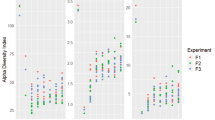Abstract
A five-stage reactor was developed to simulate the gastro-intestinal microbial ecosystem of humans. The small intestine was simulated by a two-step “fill and draw” system, the large intestine by a three-step reactor. A representative supply medium was developed to support a microbial community resembling that of the human gastro-intestinal tract. The entire system was validated by monitoring fermentation fluxes and products, i.e. indicator bacterial groups, volatile fatty acids, enzymatic activities and headspace gases. The simulator was operated with varying concentrations and combinations of arabinogalactan, xylan, pectin, dextrins and starch. The resulting patterns of microbial diversity and activity were analyzed and compared with data for in-vivo gastro-intestinal microbial communities as described in the literature and found to be reprensentative.
Similar content being viewed by others
References
Allison C, McFarlan C, Macfarlane GT (1989) Studies on mixed populations of human intestinal bacteria grown in single-stage and multi-stage continuous culture system. Appl Environ Microbiol 55:672–678
Assche P van (1978) Taxonomische studie van de Bacteroidaceae en de dominante pecies bij de big. Doctoral thesis, Faculteit Landbouwwetenschappen, RUGent
Beerens H (1990) An elective and selective isolation medium for Bifidobacterium spp. Lett Appl Microbiol 70:155–157
Bhat P, Albert MJ, Rajan P, Ponniak J, Mathar VI, Baker SJ (1980) Bacterial flora of the jejunum: a comparison of luminal aspirate and mucosal biopsy. J Med Microbiol 13:247
Bol J (1987) Influences of food on microflora of the large intestine in man. In: Leegwater DC, Feron VJ, Hermus RJJ (eds) Low digestibility carbohydrates. pp 103–113. Workshop held from 27–28 Novembeer, 1986, Zeist, TNO-CIVO, The Netherlands. Pudoc, Wageningen
Bremner JM, Keeney RD (1965) Steam distillation methods for determination of ammonium, nitrate and nitrite. Anal Chim Acta 32:485–495
Cummings JH, Macfarlane GT (1991) The control and consequences of bacterial fermentation in the human colon. J Appl Bacteriol 70:443–459
Drasar BS, Hill MJ (1974) Human intestinal flora. Academic Press, New York
Finegold SM, Sutter VL, Mathisen GE (1983) Normal indigenous intestinal flora. In: Hentges, DJ (ed) Human intstinal microflora in health and disease. Academic Press, London, pp 3–31
Gibson GR, Cummings JH, Macfarlane GT (1988) Use of a three-stage continuous culture system to study the effect of mucin on dissimilatory sulfate reduction and methanogenesis by mixed populations of human gut bacteria. Appl Environ Microbiol 54:2750–2755
Holdeman LV, Good IJ, Moore WEC (1976) Human faecal flora: variation in bacterial composition within individuals and a possible effect of emotional stress. Appl Environ Microbiol 31:359–375
Humble MW, King A, Philips I (1977) Apizym: a simple rapid system for the detection of bacterial enzymes. J Clin Pathol 30:275–277
Kitagawa K, Nishigori A, Murata N, Nishgimoto K, Takada H (1966) Radiotelemetry of the pH of the gastrointestinal tract by glass electrode. Gastroenterology 51:368–372
Macfarlane GT, Hay S, Gibson GR (1989) Influence of mucin on glycosidase, protease and arylamidase activities of human gut bacteria grown in a 3-stage continuous culture system. J Appl Bacteriol 66:407–417
Macfarlane GT, Gibson GR, Cummings JH (1992) Comparison of fermentation reactions in different regions of the human colon. J Appl Bacteriol 72:57–74
Marthinsen D, Fleming SE (1982) Excretion of breath and flatus gases by humans consuming high-fibre diets. J Nutr 112:1133–1143
Miller TL, Wolin MJ (1981) Fermentation by the human large intestine microbial community in an in vitro semi-continuous culture system. Appl Environ Microbiol 42:400–407
Nelson DP, Mata LJ (1970) Bacterial flora associated with the human gastro-intestinal mucosa. Gastroenterology 58:56
Savage DC (1992) Gastro-intestinal microbial ecology; possible modes of action of direct-fed microbials in animal production — a review of the literature. In: National Feed Ingredients Association (ed) Direct-fed microbials in animal production. National Feed Ingredients Association, West Des Meines, pp 11–81
Taylor EW, Burman NP (1964) The application of membrane filtration techniques to the bacteriological examination of water. J Appl Bacteriol 27:294–303
Veilleux B, Rowland IR (1981) Simulation of the rat intestinal ecosystem using a two-stage continuous culture system. J Gen Microbiol 123:103–115
Wilkins TD, Chalgren S (1976) Medium for use in antibiotic susceptibility testing of anaerobic bacteria. Antimicrob Agents Chemother 10:926–928
Author information
Authors and Affiliations
Additional information
Correspondence to: W. Verstraete
Rights and permissions
About this article
Cite this article
Molly, K., Vande Woestyne, M. & Verstraete, W. Development of a 5-step multi-chamber reactor as a simulation of the human intestinal microbial ecosystem. Appl Microbiol Biotechnol 39, 254–258 (1993). https://doi.org/10.1007/BF00228615
Received:
Accepted:
Issue Date:
DOI: https://doi.org/10.1007/BF00228615




